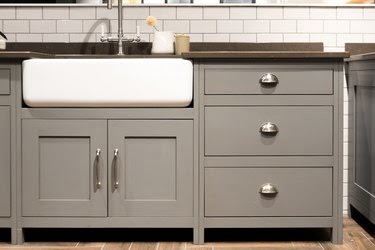Quck answer
Gel staining over painted cabinets can be a simple way to update the look of your kitchen. Here are the instructions:
1. Clean the cabinets thoroughly, removing any dirt, grease, or grime.
2. Lightly sand the surface of the cabinets to create a rough texture for the gel stain to adhere to.
3. Apply a coat of gel stain using a brush or rag, following the direction of the wood grain.
4. Allow the gel stain to dry completely before applying additional coats. This typically takes around 24 hours.
5. Apply additional coats of gel stain as desired to achieve the desired color and coverage.
6. Once the final coat is dry, apply a clear topcoat to protect the gel stain and give it a finished look.
7. Allow the topcoat to dry completely before reassembling and using the cabinets.
By following these instructions, you can transform your painted cabinets into a beautiful, stained finish that will give your kitchen a fresh new look.
If you’re eager to update worn or outdated cabinets, using a gel stain is an excellent way to transform them from tired to trendy. Gel stains are available in a wide range of colors to brighten up your space or create a bold look by darkening your doors. Unlike typical thin-liquid stains, gel stains can revive old vanities and kitchen cabinets with less effort. This is because they are thicker and provide better performance. They can save you time by eliminating the need to strip down kitchen cabinets that are in good condition. However, there are a few disadvantages to using this hard-working finish, so it is important to have some background knowledge before you begin.

How Gel Stains Function
Gel stains are relatively foolproof and contain urethane. This allows them to be applied over existing top coats with a smooth veneer or old paint and previous stains with minimal preparation work. A good gel stain usually only requires one coat to achieve a uniform look. You may choose to apply additional coats to achieve the desired color or depth of warmth for your woodwork. If you have cabinets made of man-made materials, such as fiberglass or steel, with a wood grain stamped surface, a gel stain can give it the appearance of real wood grain. Gel stain is particularly effective at providing a uniform look to uneven wood grain.
Disadvantages
If your cabinets have intricate details, you may want to avoid using gel stains. The stain tends to accumulate in tight spots, and once it is applied, it can be difficult to remove. Gel stains do not penetrate the porous surface of your cabinets but instead slide over and adhere to the surface. As a result, the final color may be lighter than intended. If you have more porous types of wood, such as mahogany, oak, ash, or walnut, especially if they are unfinished, you may want to reconsider using gel stain.
The Application Process
Once you have removed all the cabinet doors and cleaned the hinges, knobs, and other pieces with a degreaser or strong cleaning agent, you can proceed to apply the gel stain. Stir the gel thoroughly using a long paint stick. Since gel stain can stain your skin, make sure to wear protective gloves and clothing that you don’t mind getting dirty. Use a paint brush to apply the stain, ensuring that it reaches into any crevices. If you have uneven spots, you can use an old sock or rag to smooth out the coat. If you plan to apply a top coat, allow the project to cure for at least six hours, but preferably up to 48 hours. A water-based top coat is recommended for easy cleaning and is ideal for high-traffic areas.
While gel stains are easier to use compared to thin-liquid stains, it is important to have a clear vision of the desired outcome and ensure that the product is compatible with the materials you plan to refinish.

